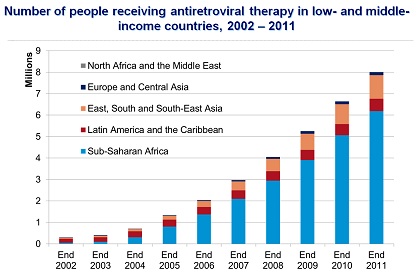The US Presents a New Plan to Achieve an AIDS Free Generation


Today is World AIDS Day, dedicated to raising awareness about the HIV/AIDS epidemic which has killed nearly 30 million people since the beginning of the 1980s. On Thursday, Secretary of State Hilary Clinton released the new US roadmap to curbing HIV infections, which ultimately aims to guarantee an AIDS free generation in the future.
On World AIDS Day last year, new scientific data was presented that demonstrated success stories in effectively implemented social and medical programs. These new developments made, for the first time, a win in the fight against HIV/AIDS seem viable. This lead Secretary of State Hilary Clinton to ask the President's Emergency Plan for AIDS Relief (PEPFAR) to develop a plan for eradicating new HIV infections in the future - a call for an AIDS-free generation.
With 34 million people living with HIV worldwide, and 2.5 million infected last year, it can be difficult to imagine an AIDS-free generation is within reach. A few elements explains this optimism. Firstly, "The progress on AIDS in the past 10 years has been incredible, after 2 decades of the epidemic getting worse and worse," explained Craig McLure, Chief of the HIV/AIDS section for UNICEF in New York, during a Reddit AMA.
Credit: WHO, UNAIDS, UNICEFIndeed, in the last ten years, thanks to the evolution of research on the virus and the increase of low-priced generic drugs, the number of people receiving antiretroviral therapy in low-and middle-income countries has increased by more than 3,000 percent, reaching 8 million people in 2011.
The massive increase in the use of AIDS treatments can be directly linked to the diminution of AIDS-related deaths, but also to a decrease in the number of infected people.
Desmond Tutu, Nobel Peace Price winner from South Africa, a country with more than 25% of its population infected by Aids, explains that an AIDS-free generation is possible. In an op-ed in the Huffington Post, Mr. Tutu writes,
"...because the antiretroviral treatment used to sustain the health of people with HIV reduces -- by 96 percent -- the chance the virus can spread. Treatment is prevention. Therefore, the more people who are tested for HIV and get medication, the fewer who contract the virus, get sick and die."Credit: WHO, UNAIDS, UNICEF
The blueprint put forth by PEPFAR emphasized the need to treat people as early as possible, before they HIV develops into AIDS, to increase the chances of survival and diminish the likelihood of transmission of the decease. The plan also prescribed an increase in the treatment of pregnant women, from conception and after childbirth, in order to prevent the virus from being transmitted to future generations, as well as increased HIV testing, implementation of broader use of female and male condoms and increased male circumstances, which can decrease the risk of acquired a sexually transmitted infections like HIV.
With the release of this blueprint, the Obama administration reaffirms its commitment to the fight against AIDS -- a commitment which will not necessarily be followed by the appropriate funding. The economic crisis has led the US and many major donors to reduce their funding to AIDS programs. With the upcoming fiscal cliff and the negotiations surrounding it, many fear the adequate resources will not be allocated.
Globally, $16.8 billion has been donated to fight AIDS in 2011, with $5.6 billion coming from the US alone. This funding provides treatment for only 8 million people out of the 34 million infected. The UN goal of reaching 15 million people by 2015 will be difficult to reach if the funding to AIDS programs remains in question.





